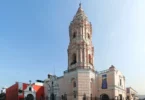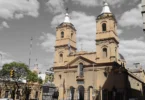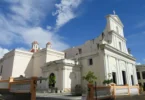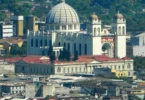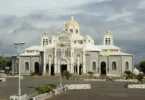Introduction
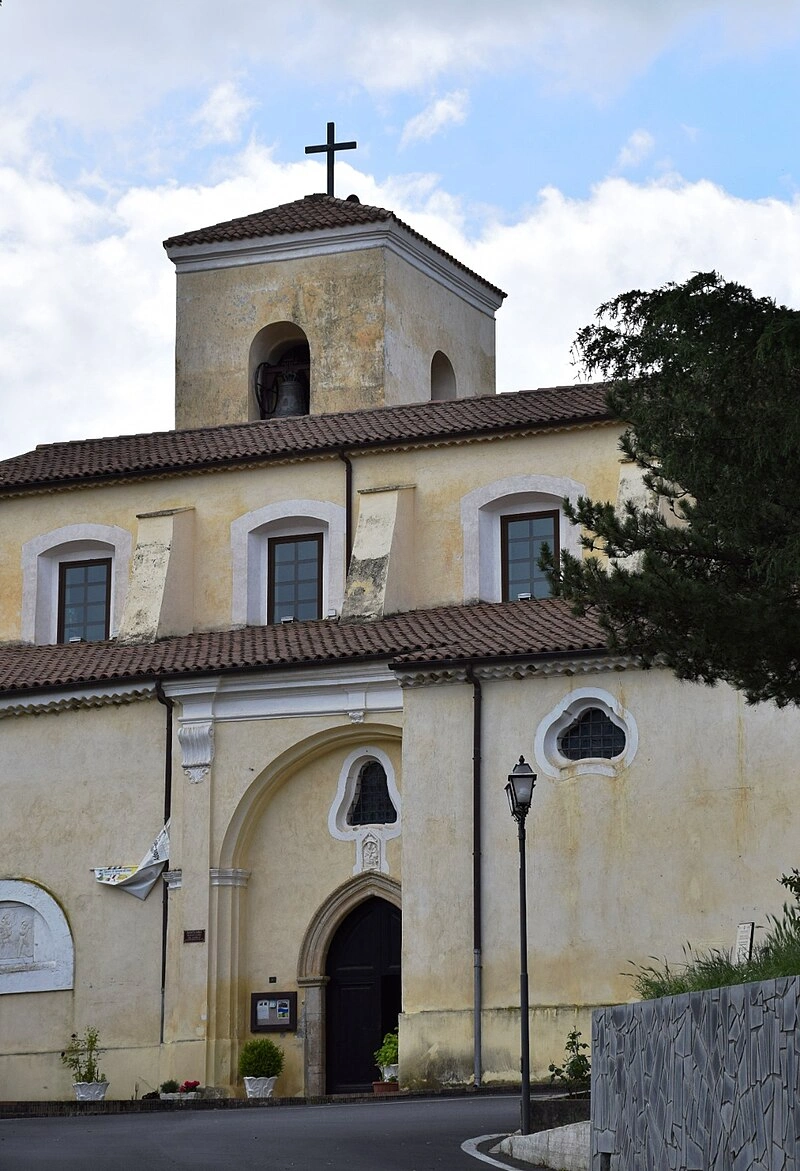
The Minor Papal Basilica of the Sanctuary of Santa Maria del Castello, commonly known as Madonna del Castello, is located in the historic center of Castrovillari, perched on a hill at 350 meters above sea level. This hill not only provides a natural vantage point for breathtaking views of the Pollino mountain range but also adds to the sanctuary’s spiritual and cultural significance. The sanctuary’s story is intertwined with a legendary tradition, centered around a miraculous image that was discovered and is enshrined within the church. Over time, this image became the focal point of a widespread votive cult, which continues to thrive today. Santa Maria del Castello holds a special place in the hearts of the people of Castrovillari and the wider Pollino region. She is regarded as the primary patron saint of the city and is deeply venerated by the local community. Each year, her feast day is celebrated with great solemnity on May 1st, marked by a grand pontifical mass led by the Bishop of Cassano all’Jonio. A key tradition of the celebration is the ceremonial delivery of the city’s keys by the mayor of Castrovillari, accompanied by the presentation of the city’s gonfalon. The feast is preceded by a solemn novena, which is held from April 21st to 29th, and on April 30th, the procession of the Madonna della Pace takes place, with the revered statue being carried through the streets of the town.
A particularly poignant moment occurs on the eve of the feast, at noon on April 30th, when the Mass of the Necklace is celebrated. During this ceremony, gold is laid and offered, and the statue of the Madonna is crowned in a deeply symbolic act of devotion. In recognition of its historical and spiritual importance, the sanctuary was elevated to the status of a Pontifical Minor Basilica by a papal decree from Pope Francis on January 3, 2022. This honor was formally conferred during a solemn Eucharistic celebration on March 25, 2022, the Feast of the Annunciation, which was presided over by Msgr. Francesco Savino, the Bishop of the Diocese of Cassano all’Jonio.
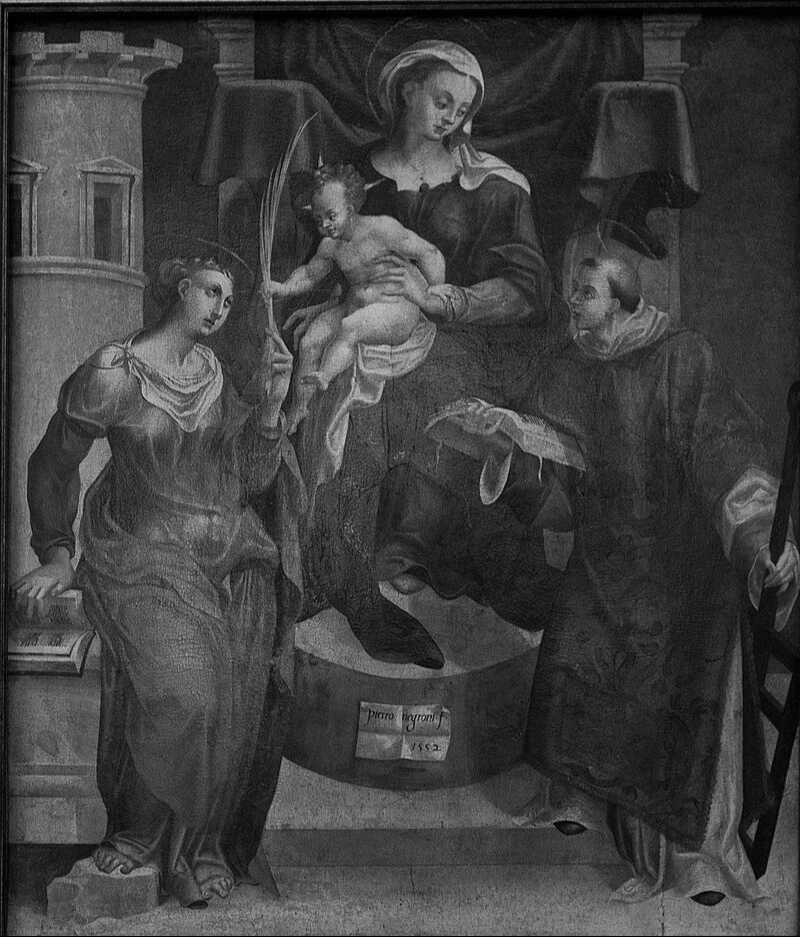
The Sanctuary of Santa Maria del Castello, also known as Madonna del Castello, has a long and fascinating history that dates back to the 11th century. The construction of the sanctuary’s original building began in 1090, under the order of Count Roger the Norman, known as “the Borsa.” Count Roger, the son of the famous Robert Guiscard, intended to build a fortress on the highest point of Castrovillari. This fortress was meant to defend against enemy attacks and to better protect his court from the hostility of the local population, who resented the Norman domination. The Normans had initially conquered Castrovillari in 1064 after a prolonged siege led by Robert Guiscard, during which the town fiercely resisted. After much struggle, the inhabitants finally surrendered due to the devastating effects of prolonged hunger. Castrovillari, however, remained a contested city even after its initial conquest. In 1073, Guglielmo Arenga, a Norman prince, rebelled against Robert Guiscard, and his son, Roger, was sent to besiege the city once again. In 1085, after Robert Guiscard’s death, Roger succeeded his father and, remembering the city’s indomitable resistance, ordered the construction of a mighty castle on the hilltop to subdue the people. The construction of the fortress began in 1090.
However, as the workers continued their labor to build the fortress, an inexplicable and miraculous event occurred. Every night, the walls of the fortress, which had been constructed during the day, mysteriously collapsed. This event astonished Count Roger, who, determined to fortify the castle, ordered the workers to dig deeper into the rock to reinforce the foundations. It was during the final phase of excavation that the miracle occurred. Workers discovered a painting of the Madonna with Child on a rock wall. Upon seeing the sacred image, the workers were struck with awe and fell to their knees in reverence, while the people of Castrovillari, hearing of the miraculous discovery, ran to the site, shouting that a miracle had taken place.
This miraculous event sparked widespread rebellion against the fortress’s construction and the Norman rule. With the support of the Bishop of Cassano, Sassone, who was a friend of Count Roger and a vicar of Pope Urban II, the count was persuaded to halt the construction of the fortress. Instead, he ordered the creation of a sanctuary to house the miraculous image of the Madonna. The image, now known as the Madonna of the Castle, was enshrined at the heart of the newly constructed sanctuary, becoming the central figure of devotion for the people of Castrovillari. The citizens, overjoyed by the miracle, gathered around the Virgin, offering her endless honors and proclaiming her the Patroness of the City.
Cultural and Religious Significance
The sanctuary’s significance extended beyond the local community. Over the centuries, numerous figures, including popes, kings, emperors, artists, and intellectuals from Italy and abroad, have visited the sanctuary to venerate the Madonna. One notable visit occurred on November 13, 1535, when Emperor Charles V, returning from his expedition to Tunis, entered the sanctuary and was so moved by the image of the Virgin that he issued a diploma granting Castrovillari the title of a city. In this diploma, Charles V decreed that every illustrious person arriving in Castrovillari should visit the Sanctuary of Santa Maria del Castello.
Valorization and Restoration Efforts
In modern times, the work of preserving and enhancing the sanctuary has been diligently overseen by Monsignor Carmine De Bartolo, the rector of the sanctuary since 1993. Significant efforts to protect the sanctuary were made after a devastating landslide in March 2012. The landslide caused the collapse of the northern slope of the hill where the sanctuary stands, making the site inaccessible to the public by car for several years. In response to this, restoration efforts began, and on August 6, 2018, a new road was inaugurated, allowing visitors to access the sanctuary once again. This road runs alongside a wall adorned with works of art by renowned local artists, further enriching the experience of visiting the sanctuary.
Elevation to Pontifical Minor Basilica
In recognition of its historical, cultural, and spiritual significance, the Sanctuary of Santa Maria del Castello was elevated to the status of a Pontifical Minor Basilica by Pope Francis on January 3, 2022. This honor was formally conferred during a solemn Eucharistic celebration on March 25, 2022, the Feast of the Annunciation. The celebration was presided over by Monsignor Francesco Savino, the Bishop of the Diocese of Cassano all’Jonio. This elevation marked a new chapter in the sanctuary’s history, further solidifying its importance to the local community and the wider Catholic Church.
Architecture of Basilica of Our Lady of the Castle, Castrovillari, Italy
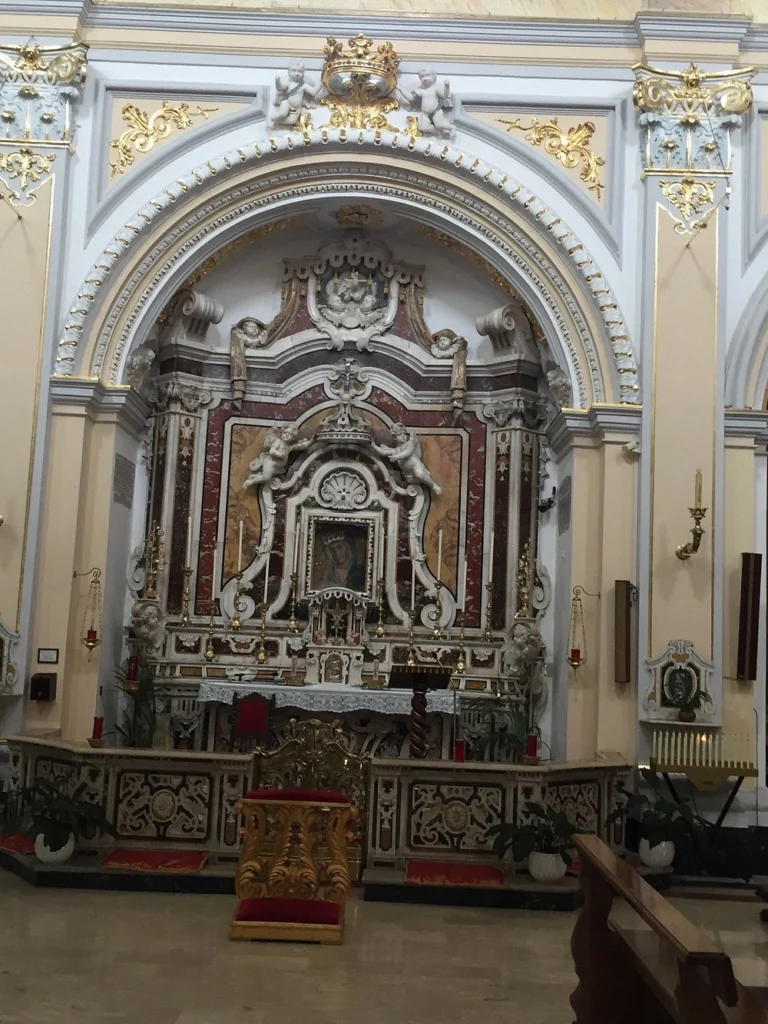
The Sanctuary of Santa Maria del Castello is a monumental church with a rich history that has undergone several transformations since its original construction in 1090. Its architecture is a fascinating blend of Norman, Byzantine, and Baroque influences, reflecting the many changes the church has experienced over the centuries.
Architecture of the Sanctuary
The church’s original structure, built in 1090 under the order of Count Roger the Norman, was rebuilt in 1363, and later underwent significant renovations in the 16th and 18th centuries. These modifications resulted in a transformation of the sanctuary’s architectural style, integrating elements from various periods while retaining traces of its original Norman design. The church has three naves, which are characteristic of the Norman style, with Arab-Byzantine friezes adorning the structure. The façade, preceded by a portico with arched windows, showcases traces of 15th-century frescoes. Two Romanesque portals can be found on the façade, surmounted by a frieze with trilobate arches, each decorated with pairs of rosettes. These portals, dating back to the 14th century, were originally located on the opposite side of the church. However, due to renovations completed in 1769, the orientation of the church was reversed. This means that the access door to the crypt and the apse now face the town center, an anomaly since churches of medieval origin are typically oriented towards the east.
The main entrance used by the faithful is on the side, corresponding to the right nave. This entrance features a pointed arch portal made of stone, showcasing clear Gothic influences. On the opposite side, there is another portal decorated in Baroque style, which was walled up during the 18th-century renovations. Inside, the central nave extends into the apse, which is occupied by the choir. The nave is supported by ten large arches, with two arches walled up to support the choir. The side naves end in two chapels, with the sacristy located on one side and a large storage room on the other. The cornice and the walls of the vault run along the arches of the choir, divided by rectangular 18th-century windows. The vault in the central nave is barrel-shaped, while the vaults in the side naves are sail-shaped, both adorned with intricate stuccoes.
The main entrance of the sanctuary leads directly to the balcony choir, which is supported by two columns and adorned with cherubs emerging from caryatids. The choir is home to an 18th-century organ, crafted from carved and gilded wood. In the center of the nave stands the Chapel of the Madonna, where the back wall is covered with exquisite marbles embedded in the wall. At the center of the chapel is the aedicule of the Madonna, with an image of the Madonna and Child, flanked by two white marble angels holding a crown. Above them, two larger angels hold another stucco crown. The altar, made of polychrome marbles, fits seamlessly with the chapel’s design and is enhanced by a semicircular balustrade. In the presbytery, at the back of the church, the high altar, which predates the 1769 renovations, deserves particular attention. It is distinguished by the beauty of the ciborium and lateral shelves, which are adorned with marble putti holding cornucopia-shaped candelabra. The altar frontal and balustrade, matching those in the Madonna Chapel, are equipped with a two-leaf bronze gate in Baroque style from 1774.
The Miraculous Madonna del Castello
At the heart of the sanctuary lies the Madonna del Castello, the miraculous image that has long been venerated by the people of Castrovillari. This iconic painting is a Byzantine-style image of the Madonna and Child, placed in a niche on the altar of the Madonna. The Madonna is depicted with large, deep eyes, a straight nose, small, full lips, and a round chin, creating a harmonious and sweet expression. Her face is framed by a blue cloak, which falls gently over her shoulders, leaving her chest exposed and covered by a white veil. Both the Madonna and Child are crowned with golden crowns, with the crowns having been donated in 1880 by Castrovillari emigrants in Buenos Aires, Argentina. In 1954, the crowns were replaced by diadems studded with diamonds, pearls, sapphires, and rubies, specially created for the Coronation of the Madonna. Every year, on April 30th, the eve of the feast day, these crowns are placed on the sacred effigy during a solemn ceremony.
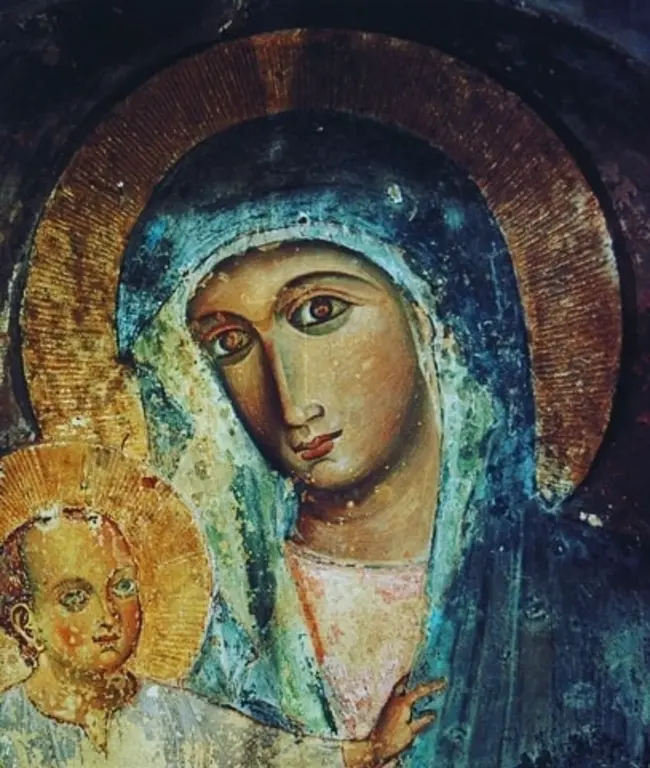
The painting is unique in its style, blending both Eastern and Western artistic influences. The Virgin holds the Child Jesus in her arms, with His hand resting on her cloak, directed towards her heart. The Virgin’s gaze is directed towards the viewer, filled with an otherworldly serenity and peace that resonates deeply with those who behold it. The colors of the painting, with their soft features and bright, neutral tones, evoke the works of famous artists like Cimabue and Giotto, adding to the icon’s allure as a masterpiece. The origins of the painting are shrouded in mystery. Local tradition attributes it to Saint Luke, while others believe it to have been of Eastern origin, hidden during the iconoclastic struggles of the 7th century. According to a local historian, Rubini, the image may have originally been a fresco in a chapel, buried over time by rubble, only to be rediscovered during the construction of the fortress by Count Roger the Norman. The workers who discovered the image, while digging the foundations for the fortress, are said to have accidentally struck the left eye of the Madonna with a pickaxe, a mark that was visible until the painting’s restoration. The Madonna del Castello remains not only a religious icon but also a powerful symbol of faith and resilience for the people of Castrovillari and beyond.
Artistic Heritage of the Sanctuary of Santa Maria del Castello
The Sanctuary of Santa Maria del Castello is not only a sacred place of worship and pilgrimage but also a veritable treasure trove of religious art. Across centuries, numerous works of art—paintings, sculptures, and architectural embellishments—have been commissioned, donated, or created by renowned and local artists, making the sanctuary one of the most artistically significant churches in Calabria.
Sculptures and Altarpieces
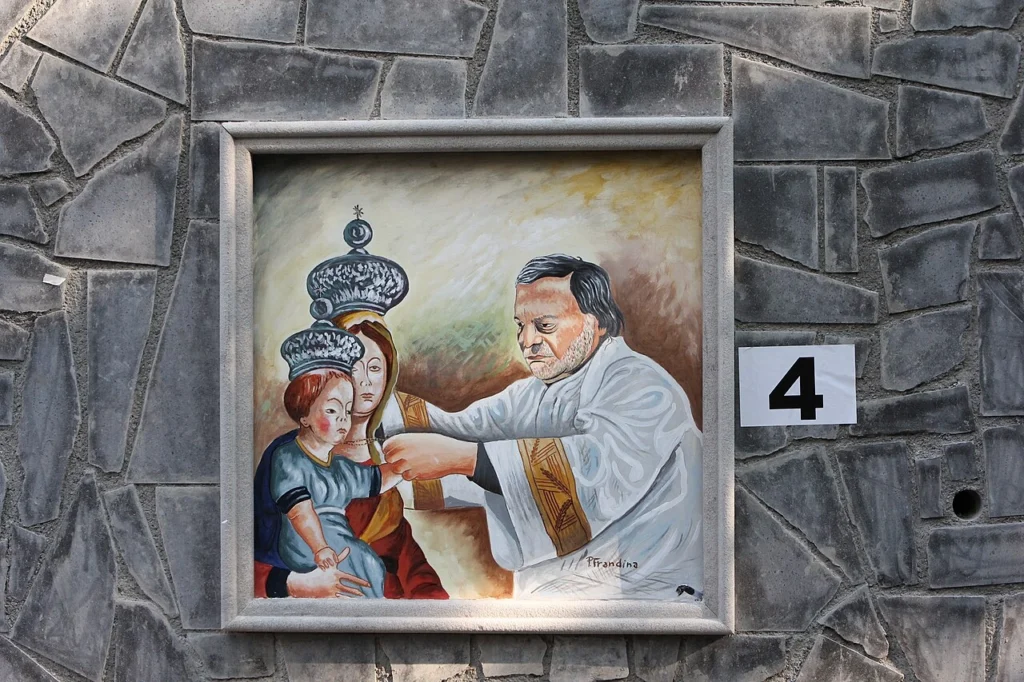
Madonna della Melagrana
To the left of the portico that introduces the altar of the Madonna del Castello is a delicate sculpted panel in white marble known as the Madonna della Melagrana. Attributed to Tino di Camaino, a disciple of Giovanni Pisano, this small yet refined work is believed to be of the Pisan school. The Virgin is depicted tenderly offering a pomegranate—symbolizing the future Passion of Christ—to the Child she holds in her left hand. Above them, a relief of God the Father appears, depicted half-length in solemn blessing. The soft modeling of the figures, their expressive tranquility, and the graceful contours highlight the artistic influence of Pisano’s school, known for bringing human tenderness into Gothic sculpture.
Major Paintings and Altarpieces

The Assumption of the Virgin by Pietro Negroni
Occupying the central position on the back wall of the apse, the main altarpiece is a grand canvas (300 × 200 cm) titled Assumption of the Virgin, painted in 1560 by Pietro Negroni, one of Calabria’s most distinguished Renaissance painters. Signed by the artist, this vibrant work portrays the Virgin Mary ascending into heaven, body and soul, surrounded by angels. Below, the twelve apostles are depicted in expressive poses, gathered around a flowering sarcophagus. Each figure reflects a variety of emotional responses, particularly Thomas, who is shown observing the blooming lily where Mary’s body should have been. The scene is dramatically rendered with Renaissance-era color dynamics, movement, and psychological depth. Influences from the likes of Raphael, Michelangelo, and Titian are evident. Negroni, a student of Marco Cardisco and mentioned by Giorgio Vasari, has here created one of his masterpieces, a work held in high esteem across Calabria.
Madonna with Child Enthroned between Saints Barbara and Lawrence
In the second chapel on the left nave, another significant work by Pietro Negroni—Madonna with Child between Saints Barbara and Lorenzo—demonstrates a clear Flemish influence and Mannerist style. Painted in 1552, during the sanctuary’s major renovations, it was likely commissioned by the Spinelli family, feudal lords of Castrovillari. The Virgin, robed in red and blue, sits on a throne holding the Child, who reaches toward Saint Lawrence’s offered palm of martyrdom. On the other side stands Saint Barbara, identified by the bronze tower of her captivity. The painting’s rich symbolism, elegant detailing, and devotional intensity reflect both spiritual depth and artistic sophistication.
The Deposition (Neapolitan School)
Near the entrance to the sacristy hangs a Deposition, attributed to the Neapolitan school, likely from the early 18th century. The anonymous artist, possibly influenced by Mattia Preti or his followers, paints a moving image of the Pietà: the grieving Madonna cradling the lifeless body of Christ. Her gaze lifted toward heaven is both resigned and reverent. The stark chiaroscuro and emotive realism reflect the influence of Caravaggio, capturing a moment of transcendent sorrow and hope.
The Circumcision by Genesio Galtieri
In a large side chapel is the Circumcision, painted by Genesio Galtieri, a native of Morano Calabro. The composition centers on Simeon, who performs the ritual on the infant Jesus. The Gospel of Luke inspires this narrative depiction, rich in symbolic elements: a vial and basin on the table represent purity and sacrifice; a servant girl holds two turtledoves for the ritual offering. The upper part of the canvas features angels and the Christogram “JHS” encircling a heart wrapped in a crown of thorns—symbolizing Jesus as the Savior of Mankind.
Madonna del Carmine
Another exquisite 18th-century canvas, possibly by Giuseppe Rimola or Simone Oliva, shows the Madonna del Carmine. She appears on a cloud holding the Christ Child, who clasps her blue cloak in a gesture typical of infants. Below, Saint Anthony of Padua, holding a lily, and Saint Anthony the Abbot, holding a book and a staff with a bell and cross, are depicted with reverence. The latter is often associated with healing and is shown with a pig, referencing the disease he was said to cure and his spiritual battles.
The Crypt
Beneath the sanctuary’s porticoed loggias lies a crypt—an atmospheric rectangular chamber with five round-arched windows and a smaller adjoining portico. The crypt opens to the exterior on the southern side of the building. Illuminated by two single-lancet windows, the crypt houses a rare and ancient Norman fresco depicting the Virgin and Child. To the right of the Madonna is a kneeling crowned figure believed to be Count Roger the Norman, the founder of the sanctuary. The fresco is framed by an architectural motif featuring two towers resting on columns—one twisted with an Arabesque capital, the other smooth. Above the heads of the Virgin and Child, six helmets appear in a semicircular band, symbolizing divine guardianship. The border contains three medallions with saints and floral motifs, and heraldic shields, one of which bears a silver horizontal band on a blue field, dating to the 11th century and attributed to a Norman feudal lord.
The Sanctuary’s Exterior: A Space of Devotion and Memory
The exterior of the Sanctuary of Santa Maria del Castello offers a serene and symbolic space that complements the spiritual and historical significance of the basilica. At the heart of the broad square in front of the sanctuary stands a fountain, its base adorned with marble relief panels sculpted in 1986 by Giannino Cherillo, a master artisan from Castrovillari. These finely crafted panels visually recount the legendary origins of the sanctuary: Count Roger the Norman selecting the hilltop site for a fortress, the workers excavating the foundations, the miraculous discovery of the sacred image of the Madonna and Child, and the subsequent divine-inspired decision to construct a sanctuary in place of the planned military stronghold. Enhancing the sacred ambiance of the square are several modern statues, thoughtfully installed in recent years. These include depictions of Saint Michael the Archangel, triumphant over evil; the Holy Virgin, invoked as the Merciful Mother; Jesus, radiating His Divine Mercy; and Sister Semplice, a beloved Castrovillari nun honored for her virtue and now on the path to sainthood. This ensemble of sculpture and storytelling transforms the sanctuary’s exterior into a place of quiet contemplation, historical remembrance, and heartfelt devotion.
Feast Day
Feast Day : 01 May
The Feast of Saint Mary of the Castle (Madonna del Castello) in Castrovillari, Italy, is celebrated annually on May 1st, with major festivities beginning on April 30th and continuing through May 2nd–3rd. It includes religious processions, the coronation of the Madonna’s image, and a solemn Mass led by the bishop.
Church Mass Timing
Saturday : 700 PM
Sunday : 10:30 AM , 7:00 PM
Church Opening Time:
Daily : Open 24 Hours
Contact Info
Address : Basilica of Our Lady of the Castle
Via Porta del Fiumicello, 87012 Castrovillari CS, Italy
Phone : +39 098 120 0456
Accommodations
Connectivities
Airway
Basilica of Our Lady of the Castle, Castrovillari, Italy, to Lamezia Terme International Airport, distance between 1 hr 22 min (129.6 km) via A2.
Railway
Basilica of Our Lady of the Castle, Castrovillari, Italy, to Tarsia Railway Station, distance between 32 min (28.1 km) via S.da Statale 19 delle Calabrie/SP241.



